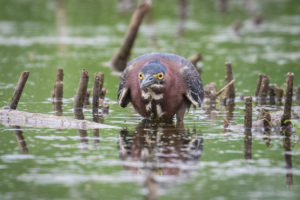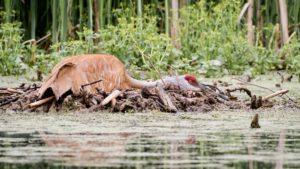 On a fine, soft morning recently a group of paddlers met at the county boat launch near Shoto to explore bird life along the West Twin River there. It was not what one would typically refer to as a beautiful day, but beautiful it was- gray, cool, calm, and comfortable. Lacking wind, it was possible to hear birds calling far away, and they too were noisily enjoying the morning. Many of the participants were Woodland Dunes staff and summer interns, joined by exceptionally nice people who enjoy paddling and wildlife viewing. And hearing, because many birds were hidden by foliage, fortunately proclaiming their presence in song. There was purpose beyond just recreation that morning- our bird checklists were submitted to the Natural Resources Foundation of Wisconsin as part of the Great Wisconsin Birdathon, a fundraiser which supports projects to conserve birds. I was birding as part of a team of birders known as the River Raptors.
On a fine, soft morning recently a group of paddlers met at the county boat launch near Shoto to explore bird life along the West Twin River there. It was not what one would typically refer to as a beautiful day, but beautiful it was- gray, cool, calm, and comfortable. Lacking wind, it was possible to hear birds calling far away, and they too were noisily enjoying the morning. Many of the participants were Woodland Dunes staff and summer interns, joined by exceptionally nice people who enjoy paddling and wildlife viewing. And hearing, because many birds were hidden by foliage, fortunately proclaiming their presence in song. There was purpose beyond just recreation that morning- our bird checklists were submitted to the Natural Resources Foundation of Wisconsin as part of the Great Wisconsin Birdathon, a fundraiser which supports projects to conserve birds. I was birding as part of a team of birders known as the River Raptors.At the start of the paddle, turning upstream, one of the first birds encountered were ospreys on their nest with a young one, then a singing Orchard Oriole- in fact there were two on opposite sides of the river, with a few Baltimore orioles also present. Next to the orchard was a singing purple finch, a very uncommon bird in the summer here. Farther up were warbling vireos singing noisily from the cottonwood trees, common yellowthroat and yellow warblers, a family of kingfishers, and many more. At one point an osprey took offense with a great blue heron, chasing it for several hundred yards, the heron squawking most of the time. Herons are opportunistic feeders, and will take baby birds if they can get at them. The young osprey was far too big, but the parent was taking no chances this day.
Farther up, toward the dam, we noticed ash trees dying from the borer, with eastern kingbirds in their branches hunting over the newly opened landscape. Robins and red-eyed vireos sang from high in the trees, and woodpeckers, including a couple of flickers, poked at the ash looking for grubs. More orioles and vireos sang from the arms of giant cottonwood trees, and we noticed a large cow parsnip plant in bloom, and many blooming Nannyberries.
As we paddled back down, American redstarts sang from brushy areas, goldfinches flew over, and a cedar waxwing, probably enjoying the flowers of the blooming shrubs, quietly sang unseen. A sandhill crane, crouched low to avoid being seen, sat on her nest. Below the boat launch, a gnatcatcher and indigo bunting called, and on a mudflat a killdeer and spotted sandpiper searched in the muck for tasty bugs. All totaled, we found more than 40 species of birds in a half mile stretch, up and back.
 The West Twin, like other local rivers, has wonderful wildlife within and along its shores. To find it requires the willingness to be patient and quiet. The number of wild creatures you see is inversely proportional to the amount of noise you make. And patience is related to the amount of time you make available for observation. It is hard to relax and see if you are on a tight schedule. So I hope you can make time in your schedule to spend some time on our area waterways. It doesn’t seem like a great adventure, but nature can surprise you. And, I hope, inspire you to think about how you can help make things even better for our rivers and lakes.
The West Twin, like other local rivers, has wonderful wildlife within and along its shores. To find it requires the willingness to be patient and quiet. The number of wild creatures you see is inversely proportional to the amount of noise you make. And patience is related to the amount of time you make available for observation. It is hard to relax and see if you are on a tight schedule. So I hope you can make time in your schedule to spend some time on our area waterways. It doesn’t seem like a great adventure, but nature can surprise you. And, I hope, inspire you to think about how you can help make things even better for our rivers and lakes.Photos- sandhill crane on her nest on the West Twin and a green heron, also on the West Twin by Shelly Randerson.
